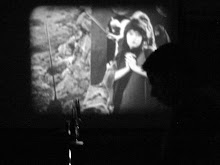The projector I was planning on using for screening Alfred Hitchcock’s “Foreign Correspondent” wasn’t quite right. The night before, as my “Star Wars” reel reached its finish the projector lamp went out. After some fiddling around, I realized the bulb was good but its fitting had a loose contact. Now every projectionist carries spares in the event of failures during screenings. These spares vary from projector to projector. Extra bulbs are mandatory, some projectors require a spare set of drive belts, perhaps a spare exciter lamp if the film uses optical sound, and so on. No one had ever advised me on stocking an extra bulb fitting.
I spent the entire day of the screening trying to fix this problem. Of course, I couldn’t. If blame games are to be played, there are some usual suspects. I bought the projector three months ago, so the seller has to be excused from any nefarious plotting. Since I’m the only one operating the projector, I am a suspect. However, the detective in charge of the investigation is always innocent. Finally, my wife is often watching films with me but suspecting her could have repercussions. So, I blame – the softest target - Murphy’s Laws and must move on.
Fortunately, I have a spare projector. Unfortunately, it is silent. Would people be up for a silent film?
“Are you up for a silent movie, honey?”, asked a man to his accompanying lady friend. She said, “I was really looking forward to watching Hitchcock.” Hmmm.......
When we projectionists speak of films, we often ask each other if the silent era will ever return. Roger Ebert suspects “The Artist” of winning the Oscar for Best Picture this year. It was successful at the Golden Globes last week. The way I saw it, tonight was an opportunity for a couple of silent films to sneak in through the back door.
“What silent films do you have?”, inquired a lady. Here was a chance to employ my foot-in the-(back)-door technique. “We could watch Douglas Fairbanks in the original Zorro, Rudolph Valentino in Son of the Sheik, the old Lost World, or Griffith’s Judith of Bethulia.”, I said.
“I’d love to watch Valentino.”, the lady said. Two other ladies said they’d like to watch something by Griffith. The back door was ajar and the silent films ran right in. I’d open with an abridgement of “Son of the Sheikh”, followed by “Judith of Bethulia”.
I threaded up the first reel on my Keystone K-100 with some apprehension. Now, I have not heard much about this projector. Projectionists I know don’t speak much about it. However, I like it. You see, unlike some of the more popular film projectors, this one requires film to be threaded manually. So, if the audience is to enjoy a movie, the projectionist must thread the film expertly. On my Keystone, a tightly looped film results in a jittery image. So, manually threading films is an art that takes some practice.
Rudolph Valentino and Wilma Banky wowed the small audience of seven. Maybe the threading was good? At the end of the first reel, there was a humorous inquiry about the working of the second reel. After the second reel, the seven ladies in the audience were generous in their applause. Perhaps the ladies appreciated - not the film, not the projectionist’s work – but Rudolph Valentino. In the 1920s, he enjoyed great popularity among the ladies. It is believed that the release of “Son of the Sheik” was arranged to coincide with his funeral, and that this association made the film a commercial success.
While the first screening was of an artist’s last, the second was of a first by the Biograph Company. “Judith of Bethulia” is directed by a silent era great, D.W. Griffith, and is the Biograph Company’s first full-feature. Griffith is known for “Birth of a Nation” and “Intolerance”, even this lesser known film is a spectacle. The audience members seemed to be awed by the scale of the production. One lady spoke of the difficulty in constructing the huge wall from whose battlements the Assyrian soldiers fought off King Nebuchadnezzar’s soldiers.
As the projectionist, one question remained. “Did you like the pictures? Enjoy the silence?” Pat came a reply, “Well, the film is a hundred years old!” Yes, they had felt like I did when I first saw the same films. Like me, they had heard the sounds of silence.





